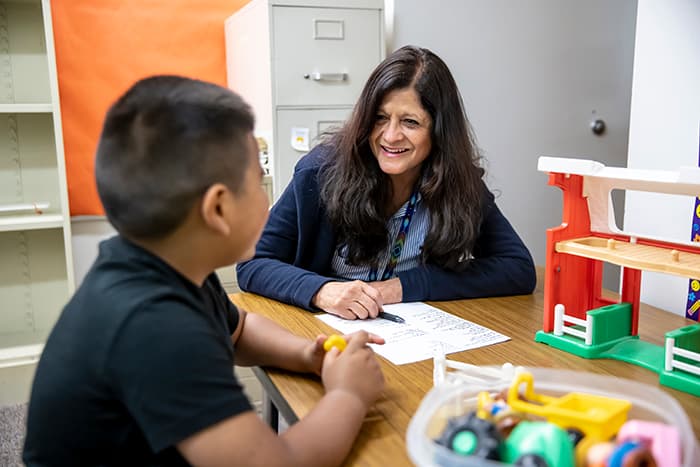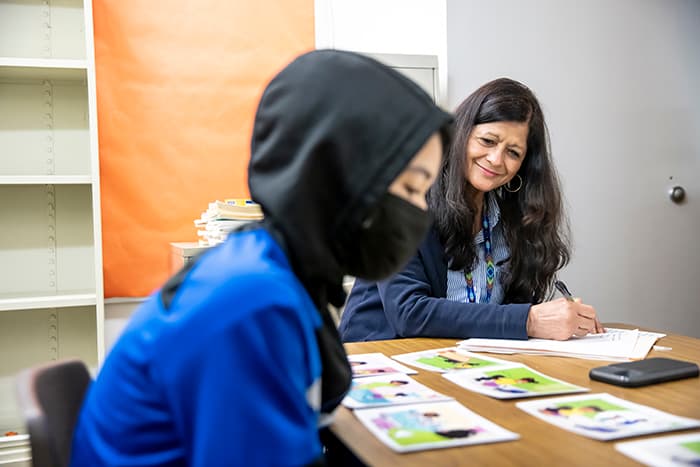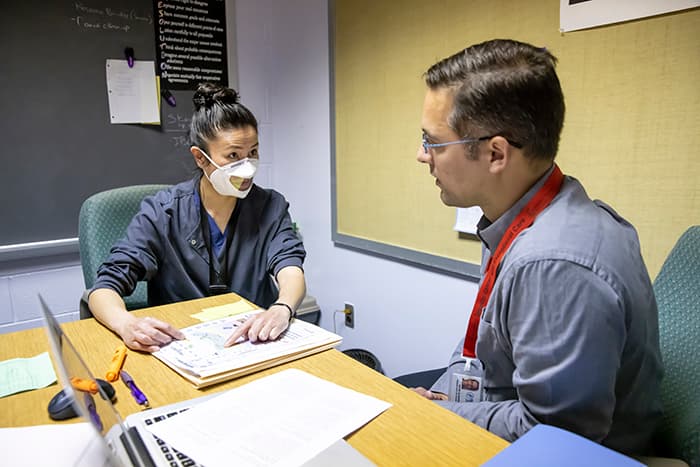Supporting HCPSS Students with Speech, Language, and Hearing Disorders
May 16th, 2022

HCPSS supports students with a wide range of needs, including those with speech, language, and hearing disorders. HCPSS employs more than 140 speech-language pathologists (SLPs), who are distributed across elementary, middle and high schools in the county and are trained to identify and treat speech and language disorders in children ages birth-21. In addition, HCPSS has two educational audiologists and four teachers of the deaf and hard of hearing, who identify, assess, and support students with hearing loss.
Cicely Williams is an SLP who works with HCPSS’ Early Intervention Assessment Team and Child Find Teams to identify children from birth to age 5 who may present with possible communication delays or disorders. She administers a combination of standardized tests and informal measures (e.g., parent and teacher surveys) to determine if a child has a speech language delay or disorder, such as fluency, articulation, social communication, language deficits, or other communication issues making it difficult for them to communicate or be understood.
“I function very much like a detective,” Williams says. “I pull together lots of information to figure out what may be going on with a child, why it is happening, and what it means in terms of next steps.”
In some cases, next steps may include additional assessments to gather more information, or, if a hearing issue is suspected, referring a child to an audiologist. Services meet each student’s individual needs, and could range from parent coaching to placement in a special education program.
“It [all] depends on what we see and how that compares to what we know is developmentally appropriate for a child of a given age,” Williams explains.
Dr. Carmen S. Alverio also is an HCPSS SLP, specializing in speech language assessments for bilingual students.
“With culturally and linguistically diverse students, it is important to determine if the difficulties the students are presenting are due to a language difference or a language disorder,” she explains. “If they have a language difference, they usually communicate in their first language following the grammatical rules of that language, and understand that language. When they speak English, they may exhibit cross linguistic influence, which is a typical phenomenon in bilingual children. They produce sentences in the second language that follow the rules of the first language.”
For example, Alverio says, Spanish/English bilingual children might say “She eat” instead of “She eats,” because in Spanish the third person singular of the present tense does not end in ‘s.’

By contrast, she says that if a student has a language disorder, they may have difficulty understanding the language and expressing their ideas and thoughts with members of their same culture and language. In the classroom, this disorder would lead them to struggle with academics.
“A defining feature of a language disorder is its presence across languages. The disorder affects the child regardless of what language they speak,” Alverio explains.
Like Williams, Alverio uses a combination of standardized and non-standardized measures to assess bilingual students. Standardized tools are used to compare a student’s performance with other students of the same age, linguistic and cultural group, and require a student to follow a specific set of directions and procedures. With bilingual children, sometimes standardized measures are used in a non-standardized manner, such as using an interpreter or implementing a dynamic assessment. In these instances, the report does not have scores, but instead contains a qualitative analysis of the student’s performance.
Alverio also serves as a resource/consultant for SLPs who use interpreters to conduct speech and language evaluations for students from culturally and linguistically diverse backgrounds. In that capacity, she helps the SLPs to review and interpret the evaluations and determine whether a speech or language disorder exists or if the child’s language shows signs of first language influence.
Alverio’s assessments are used by school-based Individualized Education Program (IEP) teams to determine if a student is eligible for SLP services. If the student is deemed eligible, the IEP team then outlines what services the student will receive, and where and when those services will be administered.

Mei-Ling Chen is one of HCPSS’ two educational audiologists, who work with children as young as 3 months old to assess them for hearing loss that may impact their speech and language development.
“In Howard County, the journey starts early to rule out hearing loss,” she explains. All babies born in Maryland undergo a hearing screening at birth. The Howard County Health Department also conducts hearing screenings at school for students who are new to the Maryland school system and those who are in prekindergarten, kindergarten, first and eighth grades.
Chen supports students with hearing impairment in a variety of ways. She works with teachers, administrators, related service providers, and parents as part of an IEP or 504 team to ensure the necessary accommodations are in place to enable such students to access instruction. This may include making recommendations for preferential seating so that students can better hear their teacher and their peers, improving classroom acoustics (e.g., tennis balls on bottom of chairs to reduce classroom noise), providing classroom notes to students who have difficulty hearing and taking notes simultaneously, and/or other accommodations based on an individual student’s needs.
Chen also helps to ensure that students have access to appropriate technology to address their hearing issues. This can include assisting a student with their personally owned hearing devices to ensure they are functioning properly as well as making recommendations for use of an assistive technology, enabling them to hear teacher voices above classroom noise.
“Every student experiences hearing loss differently, so I work with the student, their family and their teachers to make sure that their individual hearing needs are met and that they have access to instruction,” she explains.
David Alianiello, HCPSS’ program head for Hearing Services, also supports students with hearing loss and their families. Often, this begins with helping parents understand what hearing loss is and how it might impact their child’s learning and language acquisition. He also helps coordinate meetings with audiologists and other specialists (including SLPs), who parents may need to work with to support their child.
“Parents can easily feel overwhelmed when they learn that their child has hearing loss,” he says. “I try to help them by translating some of the complex technical jargon found in hearing evaluations into language they can understand, and also provide them with resources and strategies they can incorporate into their daily routine to help their child.”
When necessary, Alianiello also attends IEP meetings to help parents and families better understand the support services for which their children are eligible, and to help teachers understand what accommodations are required to meet the student’s needs. In addition, he reviews hearing assessments and conducts observations of students new to Howard County to determine whether they qualify for support services or whether additional evaluations are needed. Alianello also works directly with students who are deaf or hard of hearing on a variety of skills.

“When I work with really young students, I might focus on helping them keep their hearing aids on. As they get older, I focus more on helping them to understand the accommodations they are entitled to and to advocate for themselves, so that their hearing loss doesn’t become a barrier to learning,” he explains.
More information on speech-language and audiological services in Howard County is available online.
Signs That Your Child May Have a Speech-Language Disorder
The American Speech-Language Hearing Association outlines several signs that a child may have a speech or language disorder.
If you suspect your HCPSS student may have a speech-language disorder, reach out to the Child Find team or to your child’s school.
Signs That Your Child May Have Hearing Loss
- Frequently asks for things to be repeated
- Turns television up loudly
- Speaks loudly
- Mishears words
- Leans in or looks intently at faces during conversations
- Cocks head side to side
- Doesn’t respond when spoken to
- Difficulty hearing/identifying the source of environmental sounds (i.e. birds chirping)
HCPSS audiology can only assess a student’s hearing as part of the 504 or IEP process. If a student already has a 504 plan or IEP in place, parents should discuss their concern with the IEP team to obtain a referral for audiologic assessment.
If a student does not have a 504 plan or IEP in place, but is experiencing an academic impact that may be hearing-related, parents should contact their child’s school administration to set up a 504 or IEP Eligibility meeting. The IEP team can make the recommendation and referral for an audiologic assessment through HCPSS.
If a student does not have a 504 plan or IEP in place and is not experiencing an academic impact, parents should contact their pediatrician for referral to a private audiologist for assessment.
If a student has documented hearing loss and would like to have accommodations, parents should contact their child’s school administration to set up an eligibility meeting.
 HCPSS
HCPSS